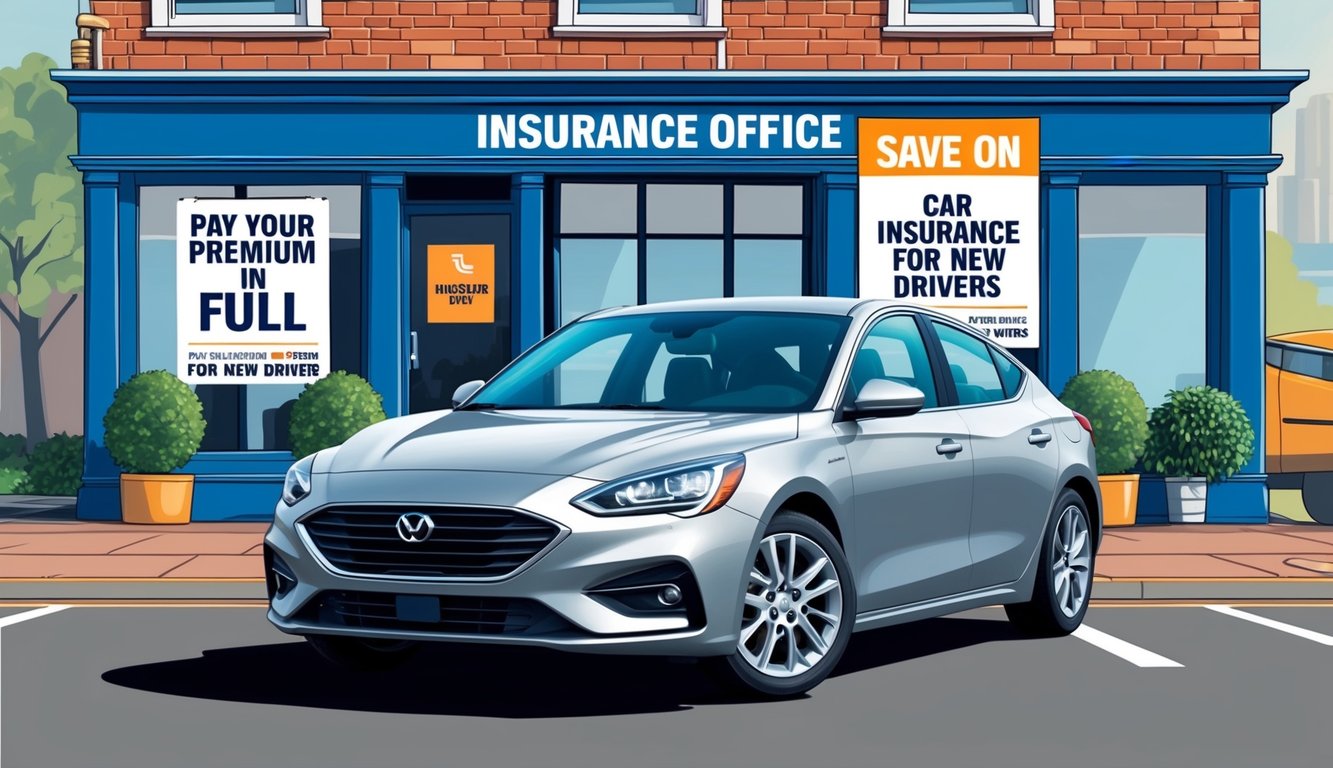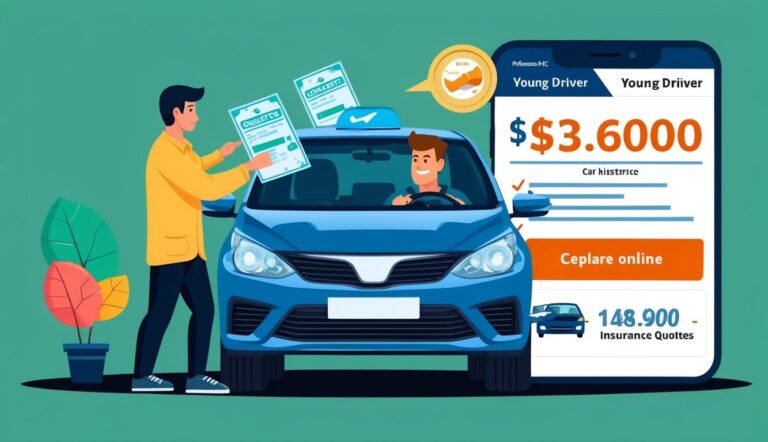Getting car insurance as a new driver can be expensive, but there are ways to reduce costs.
Insurance companies often charge higher premiums for inexperienced drivers due to the increased risk they pose.
This applies to both teenagers and adults who have recently obtained their licenses.
You can save money on car insurance as a new driver by comparing quotes from multiple providers, taking advantage of available discounts, and choosing the right coverage options for your needs. Car insurance for new drivers doesn’t have to break the bank if you know where to look and what strategies to employ.
With some research and smart choices, you can find affordable coverage that meets your requirements and budget.
1) Take a Defensive Driving Course
As a new driver, taking a defensive driving course can be an effective way to save on your car insurance premiums.
Many insurance companies offer discounts to drivers who complete these courses.
Defensive driving courses teach valuable skills that can help you become a safer driver.
You’ll learn techniques for anticipating and avoiding potential hazards on the road.
The discounts offered for completing these courses can vary between insurers.
For example, Farmers Insurance offers up to 10% off, while State Farm may provide a discount between 10% to 15%.
To get started, check with your insurance provider about approved courses in your area.
Many insurers offer online options, making it convenient to complete the training.
The duration of these courses typically ranges from four to eight hours.
They cover topics like safety information, driving techniques, and local traffic laws.
Keep in mind that eligibility rules for defensive driving discounts can vary by state.
It’s best to confirm the specific requirements with your insurance company.
After completing the course, you’ll need to provide your insurer with a certificate of completion.
This allows them to apply the discount to your policy.
The benefits of a defensive driving course extend beyond insurance savings.
The skills you learn can help you become a more confident and safer driver on the road.
2) Choose a Higher Deductible

Opting for a higher deductible can significantly reduce your car insurance premiums.
Your deductible is the amount you pay out of pocket before your insurance coverage kicks in for a claim.
Most insurers offer deductible options ranging from $250 to $1,000 or more. Raising your deductible from $250 to $1,000 can lead to substantial savings on your policy premium.
Before increasing your deductible, consider your financial situation.
Make sure you can comfortably afford the higher amount if you need to file a claim.
It’s wise to have savings set aside to cover the deductible.
Evaluate the potential savings against the increased out-of-pocket cost.
In some cases, the premium reduction may be worth the risk of a higher deductible.
Remember that deductibles apply separately to different types of coverage.
You can choose different deductible amounts for comprehensive and collision coverage.
When selecting a deductible, consider the value of your car and your driving habits.
If you have an older vehicle or a good driving record, a higher deductible might make more sense.
Keep in mind that raising your deductible is just one strategy to lower your premiums.
Combine this approach with other cost-saving measures for maximum benefit.
3) Maintain Good Grades

Good grades can lead to significant savings on your car insurance premiums.
Many insurance companies offer good student discounts for young drivers who maintain high academic performance.
To qualify for these discounts, you typically need to maintain a B average or higher.
Some insurers may also consider good scores on standardized tests like the SAT or ACT.
The savings can be substantial.
For example, State Farm offers a discount of about 17% for good students on their car insurance policies.
Other companies may offer even higher discounts.
To take advantage of this opportunity, make sure to inform your insurance provider about your academic achievements.
You’ll likely need to provide proof, such as a recent report card or transcript.
Keep in mind that you’ll need to maintain your grades to continue receiving the discount.
Most insurers require periodic verification of your academic standing.
This incentive not only helps you save money but also encourages you to focus on your studies.
It’s a win-win situation where your academic success directly translates to financial benefits.
Remember to shop around and compare offers from different insurance companies.
The amount of the good student discount can vary between providers, so it’s worth exploring your options to find the best deal.
4) Bundle Policies with the Same Provider
As a new driver, you can potentially save money on your car insurance by bundling multiple policies with one insurance provider.
This strategy involves combining your auto insurance with other types of coverage, such as renters or homeowners insurance.
Many insurance companies offer discounts to customers who purchase multiple policies.
These discounts can range from 5% to 25% off your premiums, depending on the provider and the policies you bundle.
Bundling can simplify your insurance management by consolidating your policies under one provider.
This means you’ll have fewer bills to keep track of and a single point of contact for your insurance needs.
When considering bundling, compare quotes from different insurers.
Sometimes, purchasing separate policies from different companies might be more cost-effective than bundling with one provider.
Remember to review your coverage needs carefully.
Don’t buy additional policies just for the sake of bundling if you don’t actually need them.
Focus on getting the right coverage at the best price.
Some of the top providers for bundling auto and home insurance include Amica, State Farm, and USAA.
Research these and other options to find the best fit for your situation.
5) Use Telematics or Monitor-Based Programs
Telematics programs offer a way to potentially lower your car insurance premiums as a new driver.
These programs use technology to track your driving habits and adjust your rates accordingly.
Most major insurance companies now offer telematics car insurance options.
They typically work through a smartphone app or a device installed in your vehicle.
These programs monitor factors like your speed, braking habits, mileage, and time of day you drive.
By demonstrating safe driving behaviors, you can earn discounts on your insurance.
The savings from telematics can be significant, especially for new drivers who often face higher rates.
Some drivers report saving hundreds of dollars per year.
To get started, ask your insurance provider about their telematics options.
Many offer a discount just for signing up, even before they assess your driving.
Keep in mind that consistency is key.
Maintain good driving habits throughout the monitoring period to maximize your potential savings.
Some programs, like Progressive’s Snapshot, offer personalized rates based on your actual driving behavior.
This can be particularly beneficial if you’re a cautious new driver.
6) Look for Discounts Based on Your Organization

As a new driver, you can save on car insurance by exploring discounts linked to organizations you’re affiliated with.
Many insurers offer reduced rates to members of specific groups.
Check if your employer has partnerships with insurance companies.
Some businesses negotiate group discounts for their employees, potentially lowering your premiums.
Alumni associations often provide car insurance discounts to their members.
If you’re a recent graduate, inquire about savings through your school’s alumni network.
Professional associations and unions frequently secure insurance deals for their members.
If you belong to any such groups, investigate the benefits they offer.
Military service members and veterans may qualify for significant discounts.
Many insurers recognize their service with reduced rates.
Membership in certain warehouse clubs can lead to insurance savings.
For example, some Costco members enjoy access to discounted car insurance policies.
Don’t overlook fraternal organizations or social clubs.
Groups like the Elks or Rotary Club sometimes negotiate insurance benefits for their members.
Remember to ask your insurance agent about organization-based discounts.
They can help you identify savings opportunities you might have overlooked.
When comparing insurance quotes, always mention your affiliations.
This ensures you receive all applicable discounts and get the best possible rate.
7) Shop Around and Compare Multiple Offers
As a new driver, you should compare insurance quotes from multiple providers.
Don’t settle for the first offer you receive.
You can compare car insurance quotes online from various companies to find the best rates.
Many websites allow you to input your information once and receive quotes from multiple insurers.
Take advantage of comparison tools that let you compare quotes side-by-side.
This makes it easier to evaluate different coverage options and prices at a glance.
Don’t limit yourself to just the big-name insurance companies.
Consider regional insurers as well, as they may offer competitive rates for new drivers in your area.
When comparing quotes, make sure you’re looking at similar coverage levels and deductibles.
This ensures you’re making an apples-to-apples comparison between different policies.
Pay attention to discounts offered by each insurer.
Some companies may have specific discounts for new drivers or students that could significantly reduce your premium.
Remember that the cheapest option isn’t always the best.
Consider factors like customer service ratings, claims handling, and financial stability when making your decision.
Be prepared to spend some time on this process.
Comparing insurance rates from multiple providers can be time-consuming, but it’s worth the effort to find the best coverage at the most affordable price.
8) Avoid High-Performance Vehicles

High-performance vehicles often come with higher insurance premiums.
These cars typically have powerful engines, advanced technology, and expensive parts, making them costlier to repair or replace.
Insurance companies consider high-performance vehicles riskier to insure.
They’re more likely to be involved in accidents due to their speed capabilities and are attractive targets for theft.
As a new driver, choosing a more modest vehicle can significantly reduce your insurance costs.
Opt for a car with a smaller engine and fewer high-tech features.
Family sedans, compact cars, and some SUVs generally have lower insurance rates.
These vehicles are considered safer and less likely to be stolen, which translates to lower premiums for you.
When shopping for a car, research insurance costs beforehand.
Get quotes for different models to compare potential premiums.
This approach can help you make an informed decision that balances your preferences with affordability.
Remember, as a new driver, your insurance rates are already higher due to your lack of experience.
Choosing a high-performance vehicle will only add to this cost.
By selecting a more practical car, you can save money on your car insurance and build a safe driving record.
9) Consider Low Mileage Discounts

If you’re a new driver who doesn’t spend much time on the road, you might qualify for low-mileage car insurance discounts.
These can significantly reduce your premiums.
Many insurance companies offer these discounts to drivers who travel fewer than a set number of miles annually.
The exact mileage threshold varies by insurer, so it’s worth checking with multiple providers.
To prove your low mileage, you may need to use a mileage-tracking device.
This small gadget plugs into your car and records your driving habits, including distance traveled.
Some insurers offer pay-per-mile programs, where your rate is based on the actual miles you drive.
This can be especially beneficial if you rarely use your car.
USAA and State Farm often provide competitive rates for low-mileage drivers.
However, USAA is only available to military members and their families.
Remember, even if you don’t qualify for a low-mileage discount, you can still save by accurately reporting your annual mileage to your insurer.
Overestimating your mileage could lead to unnecessarily high premiums.
If you’re considering a low-mileage discount, compare offers from multiple insurers.
The savings can vary significantly between companies, so shopping around is crucial to find the best deal for your situation.
10) Pay Your Premium in Full

Paying your car insurance premium in full can lead to significant savings.
Many insurers offer discounts for customers who choose to pay their entire premium upfront rather than in monthly installments.
When you opt for monthly payments, insurance companies often charge additional fees or higher overall premiums.
By paying in full, you can avoid these extra costs and potentially save hundreds of dollars over the course of your policy term.
While the initial outlay may seem steep, the long-term benefits can be substantial.
If you have the financial means, consider setting aside money each month to prepare for a lump-sum payment when your policy renews.
Some insurers may offer a discount of up to 10% for paying in full.
This can translate to significant savings, especially for new drivers who typically face higher premiums.
Remember to ask your insurance provider about their pay-in-full discount.
Not all companies advertise this option, but many are willing to offer it if you inquire.
If paying the entire premium at once is challenging, explore alternative payment schedules.
Some insurers offer quarterly or bi-annual payment options that may still come with discounts compared to monthly payments.
Understanding Premiums and Discounts
Car insurance premiums are influenced by various factors, and new drivers can benefit from specific discounts.
Knowing what affects your rates and which discounts you qualify for can help you save money on your policy.
Factors That Affect Premiums
Your car insurance costs depend on several key elements.
Age and driving experience play a significant role, with new drivers often facing higher rates due to their limited history on the road.
The type of vehicle you drive also impacts premiums, as expensive or high-performance cars typically cost more to insure.
Your location matters too.
Urban areas with higher traffic and crime rates usually lead to pricier policies.
Your credit score can influence rates in many states.
Maintaining a clean driving record is crucial, as accidents or traffic violations can significantly increase your premiums.
The coverage types and limits you choose affect your costs.
Higher deductibles generally result in lower premiums, but you’ll pay more out-of-pocket if you file a claim.
Available Discounts for New Drivers
Despite potentially higher base rates, new drivers can access various discounts to reduce their insurance costs.
Good student discounts are common for young drivers who maintain high grades.
Many insurers offer discounts for completing defensive driving courses, which can improve your skills and lower your rates.
You might qualify for a low-mileage discount if you don’t drive often.
Some companies offer usage-based insurance programs that track your driving habits and reward safe behavior with lower rates.
Bundling your auto insurance with other policies, like renters or homeowners insurance, often leads to savings.
Opting for paperless billing or paying your premium in full can also result in discounts.
Don’t hesitate to ask your insurer about additional savings opportunities you might be eligible for as a new driver.
Strategies for Lowering Insurance Costs
New drivers can significantly reduce their car insurance premiums by making smart choices about coverage and taking advantage of discounts.
The right approach can lead to substantial savings without compromising protection.
Choosing the Right Coverage
When selecting coverage, balance protection and affordability.
Consider dropping collision and comprehensive coverage on older vehicles.
The general rule is if your car’s value is less than 10 times the premium, it may not be cost-effective to maintain these coverages.
Opt for a higher deductible to lower your monthly payments.
Increasing your deductible from $500 to $1000 could reduce your premium by 15-30%.
Look into usage-based insurance programs.
These monitor your driving habits and can lead to discounts for safe driving.
Some insurers offer up to 30% off for consistently good driving behavior.
Consider minimum liability coverage if you’re on a tight budget.
However, be aware this provides limited protection and may leave you financially vulnerable in serious accidents.
Bundling Policies
Combining multiple insurance policies with one company can lead to significant discounts.
Most insurers offer multi-policy discounts for bundling auto insurance with other types of coverage.
Bundling your car insurance with homeowners or renters insurance typically results in savings of 5-25% on your premiums.
Some companies offer even higher discounts for multiple vehicles or additional policies like life insurance.
Ask your insurer about loyalty discounts.
Staying with the same company for several years can sometimes lead to reduced rates.
However, don’t let loyalty prevent you from shopping around.
Compare quotes from different insurers annually to ensure you’re still getting the best deal.
Consider bundling family policies.
Adding a teen driver to a parent’s policy is usually cheaper than getting a separate policy.
Some insurers also offer discounts for students living away from home.
Leveraging Driving Courses and Programs
New drivers can significantly reduce their insurance premiums by taking advantage of educational opportunities and technology-based programs.
These options not only improve your driving skills but also demonstrate your commitment to safety on the road.
Benefits of Defensive Driving Courses
Defensive driving courses offer valuable skills that can help you become a safer driver and potentially save money on your insurance.
Many insurers offer discounts ranging from 5% to 20% for completing an approved course.
These courses teach techniques like:
- Maintaining a safe following distance
- Anticipating and avoiding potential hazards
- Proper handling of adverse weather conditions
- Managing distractions while driving
To maximize your savings, check with your insurance provider about approved courses in your area.
Some companies, like GEICO, offer state-specific information on eligible courses and discounts.
Telematics Programs
Telematics programs use technology to monitor your driving habits and potentially reward safe behavior with lower insurance rates.
These programs typically involve:
- Installing a small device in your car or using a smartphone app
- Tracking factors like speed, braking patterns, and mileage
- Providing regular feedback on your driving performance
Participating in a telematics program can help you gain insights into your driving habits.
You can also identify areas for improvement and potentially earn discounts based on your safe driving record.
Many major insurers offer these programs, so ask your provider about available options.
Keep in mind that while telematics can lead to savings, they also involve sharing your driving data with your insurer.






